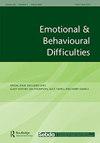A cross-sectional study on the impact of parental educational level and gender differences on emotional and behavioural difficulties in adolescents in Qatar
IF 1.5
Q3 PSYCHOLOGY, EDUCATIONAL
引用次数: 0
Abstract
ABSTRACT Heterogeneous findings on the prevalence of emotional and behavioural difficulties (EBD) have been reported in Middle Eastern countries. Moreover, the prevalence of EBD among adolescents in Qatar is unknown, making it difficult to implement the necessary educational or psychosocial programs. This study used a cross-sectional methodology to assess emotional and behavioural problems among 533 high school students from the public government schools. Only 10.6% of the students were found to have EBD, and the prevalence varied significantly in different EBD subscales, as identified using the Strengths and Difficulties Questionnaire (SDQ). The reliability of the scales was good. The population of this study had lower mean EBD scores than those reported in three other Middle Eastern countries. There were significant differences in EBD between males and females, with a higher prevalence in females. No effect of parental education was observed, suggesting that in a society with high economic stability and an excellent social structure, parental education may not be an independent factor influencing the EBD in adolescents. More studies are needed to confirm this hypothesis; however, the findings of the current study will be of importance in establishing the use of the SDQ as a tool for gauging EBD and prioritising necessary interventions.父母教育水平和性别差异对卡塔尔青少年情绪和行为困难影响的横断面研究
中东国家报道了情绪和行为困难(EBD)患病率的异质发现。此外,卡塔尔青少年中EBD的患病率尚不清楚,这使得实施必要的教育或社会心理计划变得困难。本研究采用横断面方法对公立学校533名高中生的情绪和行为问题进行了评估。只有10.6%的学生被发现患有EBD,并且在不同的EBD子量表中患病率差异显着,使用优势和困难问卷(SDQ)确定。量表的信度较好。该研究人群的平均EBD评分低于其他三个中东国家的报告。EBD在男性和女性之间存在显著差异,女性患病率较高。没有观察到父母教育的影响,提示在经济高度稳定和社会结构良好的社会中,父母教育可能不是影响青少年EBD的独立因素。需要更多的研究来证实这一假设;然而,当前研究的结果对于建立SDQ作为衡量EBD和优先考虑必要干预措施的工具的使用将具有重要意义。
本文章由计算机程序翻译,如有差异,请以英文原文为准。
求助全文
约1分钟内获得全文
求助全文
来源期刊

EMOTIONAL AND BEHAVIOURAL DIFFICULTIES
PSYCHOLOGY, EDUCATIONAL-
CiteScore
1.80
自引率
10.00%
发文量
10
期刊介绍:
The central intention of Emotional & Behavioural Difficulties (EBDs) is to contribute to readers" understanding of social, emotional and behavioural difficulties, and also their knowledge of appropriate ways of preventing and responding to EBDs, in terms of intervention and policy. The journal aims to cater for a wide audience, in response to the diverse nature of the professionals who work with and for children with EBDs.
 求助内容:
求助内容: 应助结果提醒方式:
应助结果提醒方式:


